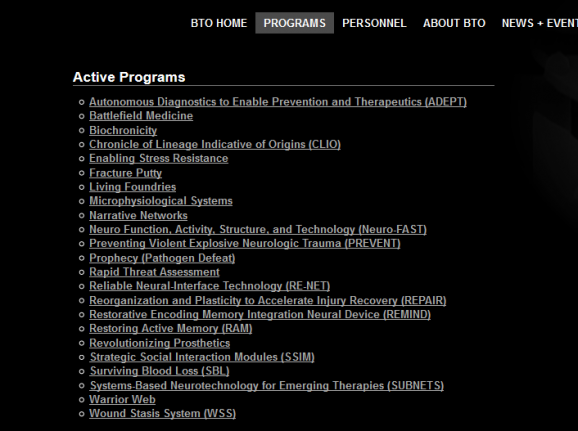DARPA Developing New Biotech Unit
This article is more than 2 years old
 Some government agencies struggle with budget constraints, while others reap the benefit of prioritization. DARPA clearly falls in the latter camp, having received a budget boost from the Pentagon. A hefty chunk of that money will go toward establishing a Biological Technologies Office for bolstering national security.
Some government agencies struggle with budget constraints, while others reap the benefit of prioritization. DARPA clearly falls in the latter camp, having received a budget boost from the Pentagon. A hefty chunk of that money will go toward establishing a Biological Technologies Office for bolstering national security.
DARPA has previously dabbled in biotech, but the new office makes it a priority and will expand on the existing offices of Defense Sciences and Microsystems Technology. The mission of the Biotechnical Technologies Office (BTO) is to “foster, demonstrate, and transition breakthrough fundamental research, discoveries, and applications that integrate biology, engineering, and computer science for national security,” and includes “human-machine interfaces, microbes as production platforms, and deep exploration of the impact of evolving ecologies.” This opens up a host of different directions and technologies for DARPA to pursue.

DARPA has always prioritized military applications of its technologies. Among other things, they want to create soldiers who aren’t limited by traditional human frailties. They’ve already developed mind-controlled prosthetics and are researching ways for soldiers to survive blood loss in the field. While most of these technologies have applications outside of the military, they can all be used to enhance soldiers’ abilities, whether it’s by boosting their brains or their bodies.
DARPA’s biochronicity program “seeks to identify common spatio-temporal instructions, or ‘clock signatures,’ in biological organisms by using empirically derived data, as well as bioinformatics and data-mining techniques.” What does that mean, exactly? It means they’re trying to better understand the way time works in the brain and the body, which could, among other things, improve human combat performance and resiliency.
Creating and understanding artificial life is another priority of the new office. An enhanced understanding of natural and biological systems would allow scientists to design and customize new systems, which would allow them to create entirely new organisms or upgrade existing ones. This makes me think of John Scalzi’s book Old Man’s War, in which elderly soldiers are upgraded into super-soldiers.
DARPA’s existing BioDesign program got an $8 million budget bump, largely to study synthetic organisms, and BTO’s Living Foundries program aims to “leverage the unparalleled synthetic and functional capabilities of biology to create a revolutionary, biologically-based manufacturing platform to provide access to new materials, capabilities and manufacturing paradigms” by “transform[ing] biology into an engineering practice by developing the tools, technologies, methodologies, and infrastructure to speed the biological design-built-test-learn cycle and expand the complexity of systems that can be engineered.” Perhaps the soldiers of the future won’t be robots after all, but rather synthetic humans, much like Battlestar Galactica‘s Cylons.
And as you might hope when it comes to biotech, DARPA also wants to prevent plagues, so it needs to study the reasons and ways outbreaks occur. Doing so means a thorough investigation of biology and ecology, which thankfully also includes population and agriculture.
Since moving into biotech could create as many dangers as it mitigates, DARPA says it will engage in ongoing discussions about the implications of its research and actions. Given that DARPA is committing to transhumanism, this is definitely good news, though not entirely comforting.












